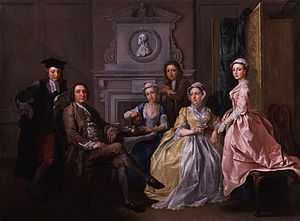Jonathan Tyers

Jonathan Tyers (10 April 1702 – 1767) was the proprietor of New Spring Gardens, later known as Vauxhall Gardens, a very popular pleasure garden in Kennington, London. Opened in 1661, it was situated on the south bank of the River Thames on a site almost opposite the present-day Tate Britain.[1]
Life
Jonathan Tyers was born on 10 April 1702, probably in Bermondsey, Surrey, and was the son of Thomas Tyers, a wool-stapler, and his wife, Ann. In 1734 Tyers purchased Denbies, a farmhouse and grounds near Dorking, where he built himself a weekend retreat. The house Tyers built by converting some of the farm buildings appears to have been of little architectural significance as very little is is known about it, but the Gothic garden he installed in the grounds became notorious. In contrast to the cheerfulness and merriment of Tyers' Vauxhall Gardens, The Valley of the Shadow of Death as it was known was designed to constantly remind visitors of their own mortality.[1] David Coke and Alan Borg, authors of Vauxhall Gardens: A History (2012) have suggested that the contrast between the two gardens may have been symptomatic of "some sort of psychological imbalance" within Tyers, perhaps even "a form of bipolar disorder".[2]
Tyers died at his home in Vauxhall pleasure gardens on either 26 June or 1 July 1767.[1]
Family
Tyers married Elizabeth Fermor (1700–1771) some time in the early 1720s, and together they had four children: Margaret (1724–1786), Thomas (1724/5–1787), Jonathan, and Elizabeth (1727–1802)). Following Tyers' death his sons Thomas and Jonathan became joint proprietors of the pleasure gardens.[1]
References
Citations
- ↑ 1.0 1.1 1.2 1.3 Ranger, Paul (2005), "Tyers, Jonathan (1702–1767)", Oxford Dictionary of National Biography (online ed.) (Oxford University Press), retrieved 15 April 2015 (subscription or UK public library membership required)
- ↑ Barrell, John (25 January 2012), "The English pleasures of Vauxhall", Times Literary Supplement (The Times), archived from the original on 15 April 2015, retrieved 15 April 2015